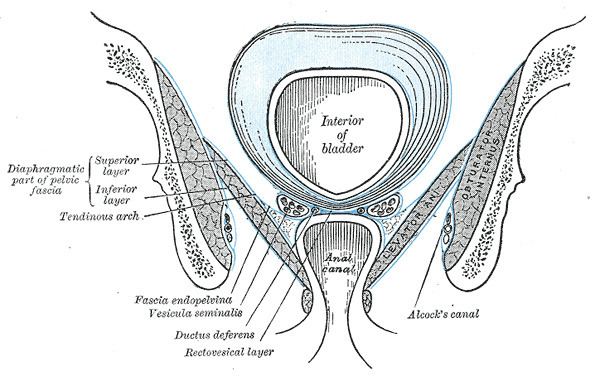TA A04.5.03.001 | Dorlands/Elsevier f_03/12355361 FMA 19725 | |
 | ||
The fascia of the pelvis can be divided into:
Contents
Fascia of pelvic organs
Pelvic fascia extends to cover the organs within the pelvis.
It is attached to the fascia that runs along the pelvic floor along the tendinous arch. The fascia which covers pelvic organs can be divided according to the organs that are covered:
Fascia of the pelvic floor
The part of the pelvic fascia on the pelvic floor covers both surfaces of the Levatores ani muscle.
The layer covering the upper surface of the pelvic diaphragm follows, above, the line of origin of the Levator ani and is therefore somewhat variable. In front it is attached to the back of the pubic symphysis about 2 cm above its lower border.
It can then be traced laterally across the back of the superior ramus of the pubis for a distance of about 1.25 cm, when it reaches the obturator fascia.
It is attached to this fascia along a line which pursues a somewhat irregular course to the spine of the ischium.
The irregularity of this line is because the origin of the Levator ani, which in lower forms is from the pelvic brim, is in man lower down, on the obturator fascia.
Tendinous fibers of origin of the muscle are therefore often found extending up toward, and in some cases reaching, the pelvic brim, and on these the fascia is carried.
The diaphragmatic part of the pelvic fascia covers both surfaces of the Levatores ani. The inferior layer is known as the anal fascia. It is attached above to the obturator fascia along the line of origin of the Levator ani, while below it is continuous with the superior fascia of the urogenital diaphragm, and with the fascia on the Sphincter ani internus.
